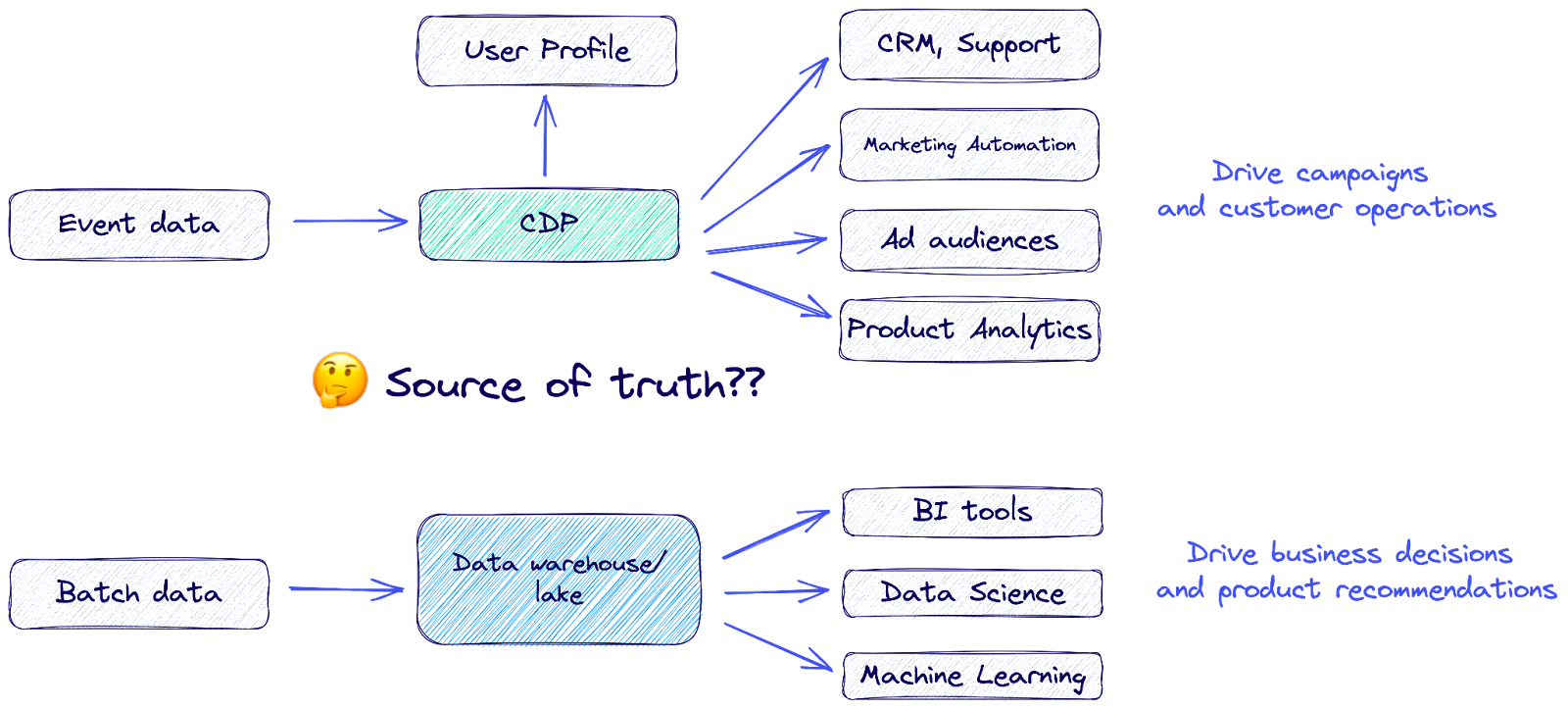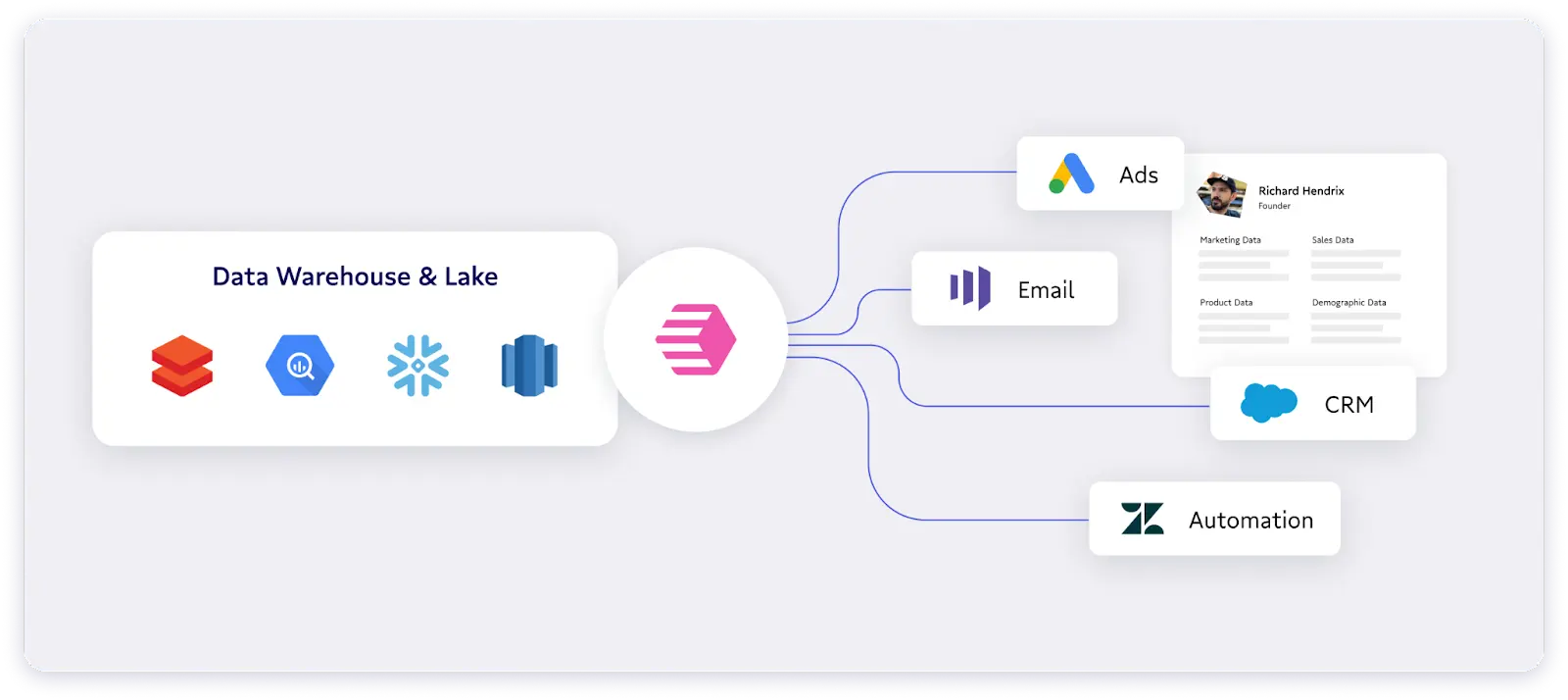When it comes to well-worn business advice, “know your customer” would be a cliché if it wasn’t so true.
Marketers have spent decades chasing the Customer 360 – the elusive 360-degree view that shows how customers think and behave in the real world. In 2023, we finally have the technology to put that holy grail and all its benefits within reach. 🏆
And not a moment too soon.
In the “recommended for you” era, personalized marketing is table stakes. More than three-quarters of consumers say personalization is key in their consideration of a brand. Almost 80 percent say they’re likely to buy again from a company with personalized communications.
But getting personalization right is easier said than done. 😖

|
A Customer 360 brings every customer data point into a single place. You get a comprehensive view of every touchpoint – every interaction your customer has had with the company.
Customers don’t see interactions with sales, marketing, and customer success as separate events. To them, it’s all one relationship. With a Customer 360, you can benefit from the same view.
5 benefits of a Customer 360
Traditionally, each department gets only a glimpse of the buyer, based on interactions with that unit. Sales bases strategy on sales contacts, marketing bases strategy on marketing contacts, and so forth.
A Customer 360 breaks down those walls. Every business unit benefits from this new, holistic view. Now:
- Marketing can use data from customer success to draft messaging around pain points.
- Product teams can use data from marketing to develop new features.
- Sales can leverage data from product teams to refine their pitches.
- Customer success can use data from all the other departments to better understand and anticipate customer needs.
It’s an ongoing, beneficial cycle; instead of building assumptions on a small piece of the profile, you all see the customer from every angle. Let’s explore why you need to holistically understand the customer journey, and what you can expect when you do.
1. Personalized customer interactions → an improved customer experience
More than three-quarters of consumers are frustrated when they expect a personalized experience and a business falls short. Folks are tired of getting the same, generic message over and over. 😤
And no wonder that’s the case – conservative estimates put the number of advertising messages the average American sees somewhere around 6,000 a day. If you want to capture attention (and who doesn’t?) you need to go beyond information and provide a relevant experience.
A 360-degree view helps you pinpoint those relevant engagements. Here’s one example: a division of Erste Group Bank AG used data about its audience’s behavior both online and offline to target investment content at under-engaged audience segments. The campaign resulted in 35 percent more conversions and 37 percent higher engagement from a historically underserved part of their market. 📈
Once your marketing messages have brought customers in the door, the Customer 360 helps other business units create a consistent experience as they guide the customer through the buying journey and beyond.
Providing a personalized customer experience throughout every stage can be a superpower in highly competitive verticals. Look at Chewy, the online pet supply retailer that has legions of superfans. Not only are those fans fiercely loyal, they also provide brand promotion worth its weight in Goldendoodles. 🐕

|
2. Nurture loyal customers, boost customer retention
Spotting opportunities to upsell and cross-sell has historically been done either manually (which doesn’t scale) or through a “recommended items” algorithm (which is hit-or-miss). The problem with most “recommended item” algos is they tend to pitch items the customer has already bought.
When your automation software draws from a Customer 360 model, it can “see” this customer’s unique history. You can target recommendations to present the items most relevant to that particular customer, not just items similar to the ones they have in their cart. 🛒
While marketing teams spend a lot on bringing in new leads, a Customer 360 also helps nurture loyal customers. For example, an insurance company with a 360-degree view of its customer base can send highly personalized messages about life insurance, good-student discounts for young drivers, and homeowner’s coverage targeted at relevant points in the customer’s life.
This sense that the business really knows them – and treats them as an individual, not a number – can foster a deep sense of loyalty in consumers. When offers are targeted and highly relevant, they get the sense that your business is looking out for them. And they’ll reward you with more business.
3. Flag cross-sell and upsell opportunities (and prevent churn before it happens)
Traditionally, if you have a spidey sense for when it’s time for the upsell (i.e. a customer hits a feature gate, they’re utilizing additional user seats, or they’re increasingly engaged), you can reach out.
But most teams want to adopt scaled tactics for more efficiency and proactivity – and there’s a whole wealth of product usage data housed in the Customer 360 you can exploit to build a growth-targeting model and automatically flag accounts. 🚩 That means monitoring for signs that a customer is ready for an upsell, cross-sell, or that their loyalty is fading altogether.
Let's face it: Customer churn is expensive. Say, for example, your organization's average contract value is $40,000. If you lose even 10 customers – valued at $40,000 each – to churn in a given year, your organization annually loses upwards of $400,000 in ARR. 😬
But by using data from a Customer 360 model, companies like Onfido, an ID verification platform, can watch for signs a customer is about to churn. Customer success then gets a heads-up so they can proactively reach out with solutions to resolve customers’ issues before frustration drives them to leave.

|
And ultimately, when you retain more customers, you increase your revenue per customer and improve your overall sales performance.
4. More informed decision-making identifies new market opportunities
The days of executives making decisions based on a gut feeling are gone. Only the data-driven survive.
Predictive analytics are among the most valuable applications of a Customer 360 model. With a big-picture view and some sharp data analysis, your company can predict trends before they hit. 🔮
It’s how businesses manage to release a new product just at the moment the market can’t get enough of it. Watching the trend for signs of waning interest creates an opportunity to reduce inventory before demand plummets (and you find yourself with a warehouse full of fidget spinners no one wants).
The rich data insights you get from a holistic view can improve confidence and accuracy as you decide everything. The crazy thing is, the data’s already there. All a Customer 360 model does is make it operational. 🤯
5. Less friction means faster issue resolution
We’ve all been on the receiving end of impersonal customer service. You share information about your account and your issue with an automated form. You get connected with a support rep and have to share the information again. A week later, when you follow up on the status of your ticket, guess what? You have to answer the same questions. 🤬
It’s frustrating for people on both sides of the call. The customer wonders if their issue even matters to anyone at your organization. The support reps, genuinely trying to provide the best possible customer service, would find their jobs so much easier if they just had the historical context around the customer’s interactions.
A Customer 360 takes the friction out of the experience because the model relies on a single source of truth. For many companies, it’s an opportunity to streamline their operation. Duplicate data and redundant workflows are eliminated, improving ROI. 🚀

|
But this also empowers support teams to see the customer’s complete history, giving them the context they need to ask for relevant information. They don’t have to keep rehashing what’s already been said.
They may even be able to spot the issue culprit from the context. Purchase history could tell them the customer didn’t order a component they need for their desired application. Customer address could tell them if the customer is in a country that restricts certain features of the software.
Building a Customer 360 is easier than you think
Your business already has tons of data on your customers, their interactions, and their behaviors. Most of it is not being used to its full potential. A Customer 360 uses this information to create the targeted, relevant experience audiences crave.
Companies that implement a Customer 360 model benefit from:
- More targeted marketing
- Faster and better resolution of customer issues
- Higher average order values and lifetime values
- Streamlined workflows
- Increased customer loyalty and satisfaction
But let’s be clear: Building one does not require throwing out your current model and starting from scratch. It just involves integrating the technology you’re already using to create a single source of truth.
⚡ Once you’ve consolidated all that siloed data into a central location, a reverse ETL tool like Census distributes it to every team in its most usable format. If you’re ready to take “know your customer” to a whole new level, book a demo with a Census product specialist.

















